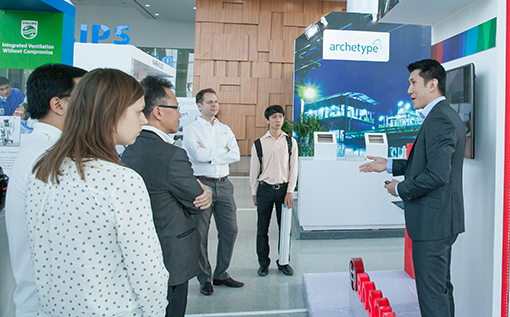Science - Technology: The essential foundation for a smart city
Currently, the construction of smart city associated with science - technology is becoming the trend of many countries. In particular, the application of information technology is to create the connection; all processes will be controlled remotely or automated without the need for human intervention.
Applying high technologies
To Binh Duong Province, at present, new urban areas are invested with technical infrastructure conforming to planning with the urbanization rate of over 76%. However, along with this development, Binh Duong are facing many challenges, due to the robust population growth, problems of social security order, traffic safety, environmental pollution, and limitations of healthcare, education, accommodation, employment... “These are problems mostly concerning policy makers of Binh Duong province. Finding a smart technology system is considered as the solution to ease pressures on social and environmental issues in urban centers”, said Mr. Tran Thanh Liem.

Netherlandish enterprises introduced solutions to smart city at Binh Duong Province Smart City Conference
According to experts, digital solutions, information technology and communications make urban management easier. With the idea of connecting multiple devices together can solve many issues while building smart cities, including IoT solution (Internet of things - a set of devices is capable of connecting together, with the internet and with the outside world to perform a certain task) is selected by many cities around the world.
"IoT has evolved from the convergence of wireless technology, micro-electromechanical technology and the internet. A specific example, in addition toasting bread, a toaster is capable of connecting to refrigerator. Users can control a toaster from refrigerator through a mobile phone or wearable devices with internet connection, regardless of space, time and place”, said Mr. Matteo Vezzosi, Senior Director of NXP Semiconductors Company (Netherlands).
Green city, connection city
A smart city not only has connections. In recent years, green building is one recommended type in many countries. Accordingly, works meeting new construction standards are works that reach high efficiency in using energy and materials, and limit negative impacts on the environment. Building structures in the future will include activities, regeneration and adaptation. New buildings will be provided by natural environmental resources, exploit rainwater, wind and light as power supply sources…
In addition, energy saving is one of the top criteria of a smart city. Smart grid combined with a distribution system of new energy, such as fuel tanks or the use of renewable resources (solar, wind...). Mr. Peter Portheine, Director of Brainport Development (Eindhoven city, the Netherlands) said many cities around the world had succeeded in applying high technologies into electricity management and use, like Masdar (United Arab Emirates), Paredes (Portugal) use solar energy for air-conditioning to minimize impacts on the environment. The employment of smart solutions to reduce social costs and resource consumptions, effectively manage energy, reduce pollution and traffic congestion as well as enhance security, improve service quality, creating potential and opportunities for investors and mobilizing external resources. Therefore, the people’s cost of living will be cheaper, life will be more sustainable and efficient.
Turning towards a smart city, Binh Duong province has focused on comprehensive administrative reform, creating all favorable conditions to serve the people and enterprises; and mobilizing all resources to serve the socio-economic development… The province also developed public transport system with the first phase of developing local bus system and BRT routes (bus rapid transit). The province has also focused on cultivating human resources, public health care. These have formed a solid foundation for Binh Duong to advance to a smart city.
Mr. Tran Thanh Liem, Chairman of PPC, said that smart solutions operated synchronously would increase the interaction between citizens and state agencies to form a democratic forum solving many existing social problems, turning towards a new worth-living city.
According to experts, a smart city must apply the "strategic triangle" model (Triple Helix): government - schools, institutes - enterprises. Accordingly, schools, institutes generate new ideas; business (or business community) is the owner of technological products; government supports ideas, supports entrepreneurship through funding. Mr. Tran Thanh Liem, Chairman of PPC, said that this model was a valuable experience from Eindhoven city (the Netherlands). The province will attempt to implement synchronous solutions to elevate urban space and soon become smart cities.
Reported by Khanh Dang – Translated by Ngoc Huynh

